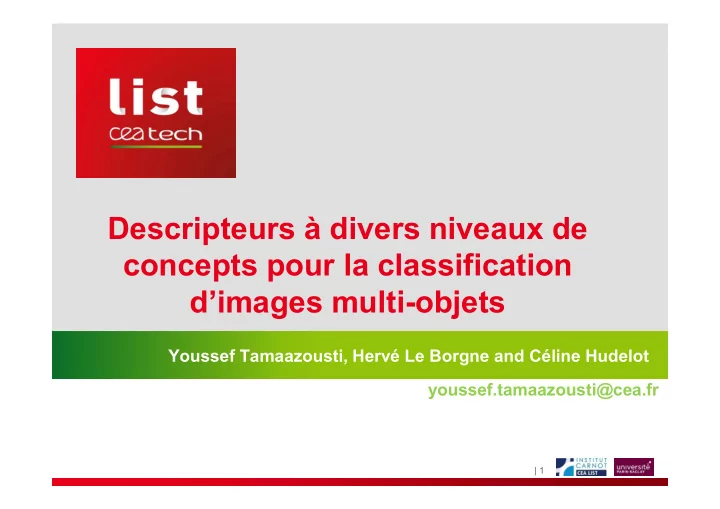

Descripteurs à divers niveaux de concepts pour la classification concepts pour la classification d’images multi-objets Youssef Tamaazousti, Hervé Le Borgne and Céline Hudelot youssef.tamaazousti@cea.fr | 1
Image Classification Labels OFFLINE Image Image Model Training training Description Description database Image Image comparator ONLINE Description Description Test image • Bear • Wood • Grass ICMR 2016 | Tamaazousti Youssef | 2
Image Classification Labels OFFLINE Image Image Model Training training Description Description database Image Image comparator ONLINE Description Description Test image • Bear • Wood • Grass ICMR 2016 | Tamaazousti Youssef | 3
Image description • Low/Mid-Level Features • Image described in terms of contours and shapes • Semantic Features • Image described in terms of semantic concepts ICMR 2016 | Tamaazousti Youssef | 4
Semantic Features • Torresani et al. , 2010 – Li et al. , 2010 • Describe images in terms of outputs of concept- detectors • Each value is associated to a humanly-understandable word ICMR 2016 | Tamaazousti Youssef | 5
Sparsification • Wang et al. , 2010 – Ginsca et al. , 2015 • Keep only the K highest values of the vector and set all others to zero ICMR 2016 | Tamaazousti Youssef | 6
Positioning • SVM one-vs-all • Multi-Layer neural network • etc. ICMR 2016 | Tamaazousti Youssef | 7
Classificatin with Semantic Features • Object classification • Without sparsification • No missing information but noisy values (not good) • With sparsification • No missing information (good) Not sparse Sparse ICMR 2016 | Tamaazousti Youssef | 8
Classificatin with Semantic Features • Multi-Object classification • Without sparsification • No missing information but noisy values (not good) • With sparsification • Missing information (not good) Not sparse Sparse ICMR 2016 | Tamaazousti Youssef | 9
Problem • Typical problematic case • Image with multiple objects • Observation • Observation • When the concept of the largest object is activated, a set of its annex concepts is also activated • Why are we loosing information? • Naive sparsification • Would select one principal concept and its annex concepts • Other principal concepts could be set to zero ICMR 2016 | Tamaazousti Youssef | 10
Usual formalism • Sparsification [Wang et al. , 2010, Ginsca et al. , 2015] • Principle • Set to zero « some » values of the vector • Objective • Objective • Keep the good concepts and delete the bad ones • Usual definition • Good concepts = highest values • Bad concepts = all others ( lowest values) ICMR 2016 | Tamaazousti Youssef | 11
Proposed formalism • Proposed definition • Good concepts = principal concepts and their annex concepts (not necessarly the highest values) • Bad concepts = all others (not necessarly the lowest values) values) • Questions 1. How to get the good concepts? 2. What are the good concepts ? ICMR 2016 | Tamaazousti Youssef | 12
1. How to get the good concepts ? • Get the good concepts is a hard problem ! • Bergamo et al. , 2012 (Bottom-up) • Get generic concepts ( good concepts ) using unsupervised clustering (hard) • Bottom-up: Low-level errors are propagated to upper • Bottom-up: Low-level errors are propagated to upper concepts → limited performances • Our proposal (Top-Down) • Get the good concepts using largely available Human Knowledge databases (hierarchies, human- categorization rules, databases, etc.) ICMR 2016 | Tamaazousti Youssef | 13
2. What are the good concepts? • Inspired by Psychological studies • Rosch, 1978 - Jolicoeur et al. , 1984 • Different levels of good concept in Human minds • The concepts mostly known and used by Humans • are • Superordinate: vehicle • Basic-level: car • Subordinate: ford mustang ICMR 2016 | Tamaazousti Youssef | 14
Observations Basic Super- level ordinate Subordinate Subordinate Number of concepts- Range of values of detectors concept-detectors Superordinate Low Low Basic-level Normal Normal Subordinate High High ICMR 2016 | Tamaazousti Youssef | 15
Proposed approach • Concept-detectors • Superordinate • Semantic process High range of values • Basic-level • Visual process • Subordinate • Subordinate • Visual process + reduction of number of concepts Low number of concepts Number of concepts Range of values Superordinate Low Low High Basic-level Normal Normal Subordinate High Low High ICMR 2016 | Tamaazousti Youssef | 16
Proposed approach • S.O.T.A semantic feature G G 0 0 • Our final semantic feature (D-CL) • Our final semantic feature (D-CL) ICMR 2016 | Tamaazousti Youssef | 17
In practice • Hard to set the list of superordinate , basic- level and subordinate concepts input image Final Semantic feature Get the diverse levels of concepts ICMR 2016 | Tamaazousti Youssef | 18
Experimental Protocol Pascal VOC 07 Pascal VOC 12 Nus-Wide Object Benchmark Rate of multi-label 45% 30% 20% • Evaluation metric • • mean Average Precision (mAP) mean Average Precision (mAP) • Pascal VOC 07 • Train/val: 5k images - Test: 5k images • Pascal VOC 12 • Train/val: 10k images - Test: 10k images • Nus-Wide Object • Train/val: 20k images - Test: 15k images ICMR 2016 | Tamaazousti Youssef | 19
Multi-Ob j ect Classification Results Without sparsification Naive sparsification ICMR 2016 | Tamaazousti Youssef | 20
Conclusions • Novelty: • New semantic image-representation • New formalism of sparsification • New sparsification process based on Human-cognition • Results: • Multi-object classification • 3 publicly available benchmarks • +2 points of mAP compared to the best state-of-the-art semantic features ICMR 2016 | Tamaazousti Youssef | 21
Thank you (questions ?) (questions ?) Commissariat à l’énergie atomique et aux énergies alternatives Institut List | CEA SACLAY NANO-INNOV | BAT. 861 – PC142 91191 Gif-sur-Yvette Cedex - FRANCE www-list.cea.fr Établissement public à caractère industriel et commercial | RCS Paris B 775 685 019 | 22
Recommend
More recommend